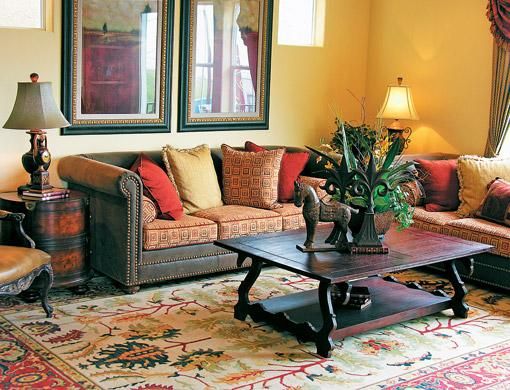New trends in interior design focus on classical tones and textures to breathe new life into living spaces.
With long working hours, hectic social lives and traffic-laden journeys it is vital that when UAE residents return home, it is to a place that refreshes the spirit, relaxes the mind and allows them to unwind. Although a home's location is important, it is the décor that defines a space and creates an atmosphere. Just as new fashions emerge in the world of haute couture, the interior design world advances by embracing new trends.
According to Irina Rudsrud, a Dubai-based interior designer, the latest trend is a celebration of the past. "To sum up this year's European exhibitions, such as Formex, we are going back to the roots," she says.
Contemporary trend
Kenneth Laidler, President of the Association of Professional Interior Designers (APID), agrees. "Things from the past are making a comeback," he says. "It is more of a spiral than a circle, however. For instance, décor from previous decades will now have a different slant or focus. This is perhaps due to the technological advances and availability of new materials."
Of course in the UAE, the Arabic influence is a prevalent contemporary trend. Eiko Fajita-Summers, a senior designer at Above consultancy firm, believes it is crucial to be consistent in the vision of the design. "Dubai still retains the will to aggressively innovate, especially with technology and materials, throughout the design process," she says. "However, the city has now started to go back to its more traditional and cultural heritage. There are a lot of new projects that incorporate local features into the design and décor."
With an influx of TV shows and a wide array of interior design magazines on the market, many homeowners are becoming more adventurous in their choice of décor. These amateur interior designers often turn to fashion for ideas and inspiration. "Black is a huge trend in interior design," says Rudsrud.
"The metallic look inspired from catwalk trends is also big news."
Popular in hot climates, tiles are no longer considered just as flooring but are now being used to make a real statement. "The size of a tile is important now. Big tiles are in," says Rudsrud. "They have always existed, but now it is trendy. To choose the right size of tiles is crucial, as it can manipulate the visual size of the room."
According to Rudsrud, shape is as important as size when it comes to trendy tiles. "Big patterns are hot and they suit the new shape, which is rectangular," she says. "You can create a stunning, exquisite tapestry wall in your living room using these kinds of tiles."
If you prefer to keep your walls tile-free and a little more traditional, there is a large selection of paints on the market. Jotun paints has been in the Middle East since 1974. The company opened its 1,000th multicolour centre in Ghusais in September 2008 and a key feature of it is the colour bar. "The colour bar represents a unique selection of the most popular colours, which are displayed in an easy-to-use format," says Patricia Younan, interior brand manager, MENA region for Jotun Paints. "It consists of 960 individual, colour swatches. Customers are encouraged to select from this collection. They can take swatches home and match them against soft furnishings," says Younan.
Younan believes the multicultural nature of UAE society is reflected in the diverse tastes in paint colours. "The differences are apparent in the brightness of paints chosen," she says.
"For example, Arab customers prefer dark colours. Indians prefer bright colours and western people always chose pastel colours. That said, greens and yellows are always popular. This is possibly because they provide the look of freshness in any room."
Up-scale interior design service
By 2015, it is expected the number of hotel rooms
in the UAE will triple from 60,000 to 180,000. This has driven the demand for an up-scale interior design service. Laidler believes a world-class interior design team can provide a crucial edge in a highly competitive market.
"Hotels want something novel to sell their product," he says. "Interior architects can assist in planning the optimum usage of a space and therefore they have the power to make or break a hotel's reputation."
In recent months, the global economy has not been as buoyant as it once was and Laidler believes this may have an effect on the world of interior design. "Interior designers feel the pinch six to nine months after architects," he says. "Architects will feel it when the construction industry slows down."
But his views are not universally shared. "Some of the best works were made in the last recession.
Instead of using expensive materials and finishes, designers have to design much more creatively in order to sell their work," says Fajita-Summers. "I hope to see some exciting designs rising from the "credit crunch blues."
Index Dubai 2008
Interior design professionals from countries throughout the Gulf and beyond will descend on Dubai from December 3-7 at the Dubai International Exhibition Centre to attend the Index exhibition and chase regional contracts worth an estimated $59 billion.
The first international Index exhibition took place in Dubai in 1992 and featured 200 exhibitors from 12 countries. "The initial aim was to assist the growing interior design industry in the Arabian Gulf in sourcing products required for continuing expansion," says Kim Willis, exhibition director of Index. "This was in addition to providing global supplier companies with a quality trade fair and to give them access to new markets in the Middle East."
This year, Willis expects 40,000 visitors to the exhibition and more than 2,000 exhibitors from around 57 countries to participate. "The exhibitors will include the major global suppliers, as well as most prominent manufacturers and retailers in the Gulf region," he says. "The essence of Index is it covers not only all sectors of the interior design markets but [it also covers] all styles that define the interiors in the region."
During this year's exhibition, presentations will be made for the first, second and third place in Al Habtoor ISG Young Designers Award, which aims at fostering young creative talent. This year, the prizes were awarded to the American University of Sharjah, Ajman University and MAHE Manipal University respectively.
There is also the Red Dot award. "The Red Dot organisation judges all products in line with strict design criteria and displays them at the Red Dot design museums in Essen, Germany, and Singapore," says Willis. "In an exclusive arrangement, the top award-winning designs from Red Dot will be unveiled for the first time in the Middle East
at Index 2008. This will act as a benchmark for product design throughout the Arab world."
- More information on the exhibition can be found at www.indexexhibition.com








